Critical Appraisal of Qualitative Research: Data Analysis and Rigor
VerifiedAdded on 2022/12/30
|8
|2634
|53
Report
AI Summary
This report provides a critical appraisal of qualitative research, focusing on key concepts such as trustworthiness and rigor, and their importance in ensuring the quality and integrity of research findings. The report examines the components of trustworthiness, including transferability, credibility, confirmability, and dependability, as well as the criteria for establishing rigor in qualitative studies. It delves into the significance of addressing rigor and trustworthiness to maintain research quality, transparency, and the minimization of bias. The report also analyzes the process of sample selection, data collection methods such as semi-structured interviews, and data analysis techniques, including grounded theory, to assess the overall research methodology. It evaluates the ethical considerations, including informed consent, confidentiality, and anonymity, to determine the trustworthiness and rigor of the research. The report concludes by emphasizing the importance of data analysis and presentation of results in enhancing the quality and impact of qualitative research.

Critical Appraisal of
Qualitative Research
Qualitative Research
Paraphrase This Document
Need a fresh take? Get an instant paraphrase of this document with our AI Paraphraser
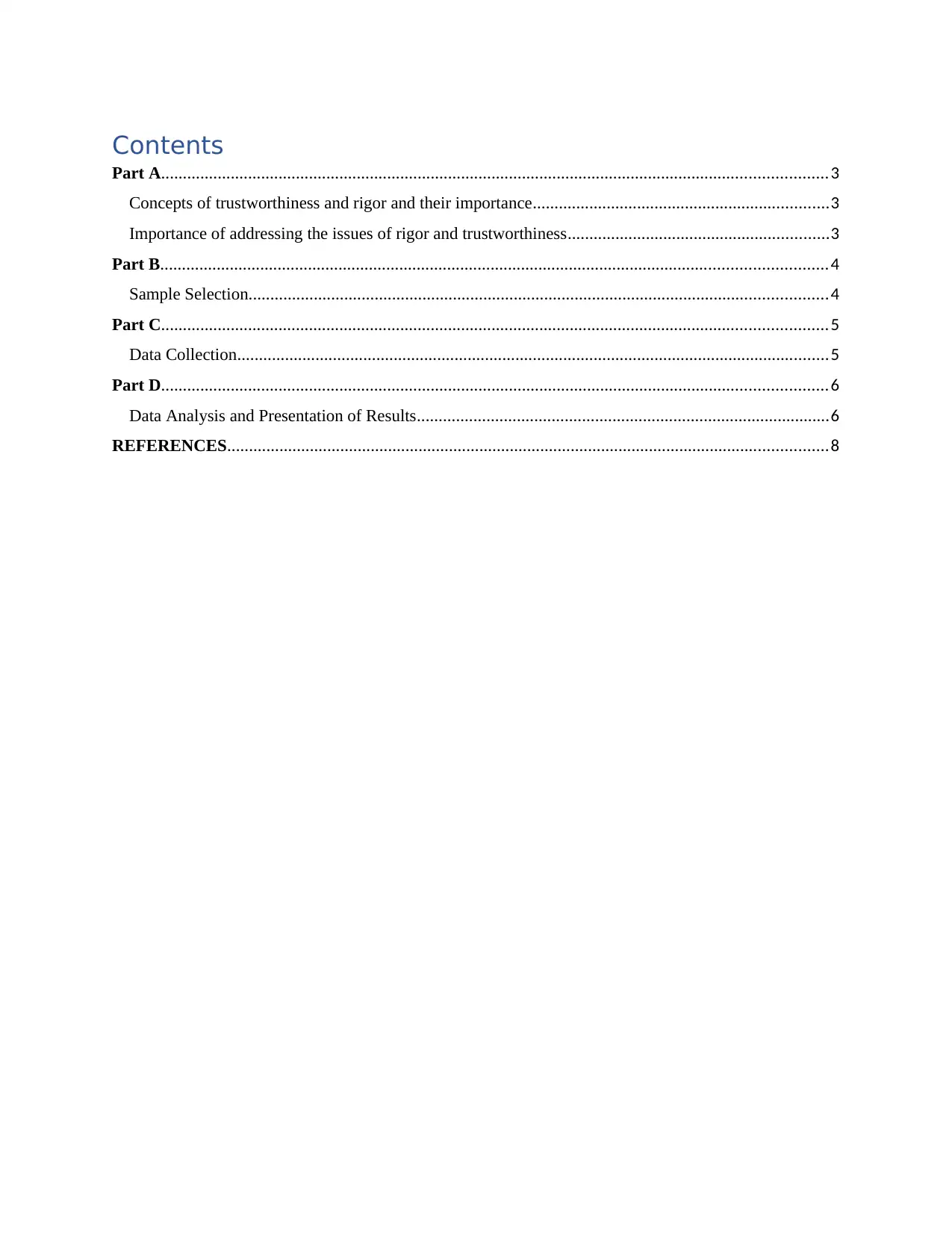
Contents
Part A.........................................................................................................................................................3
Concepts of trustworthiness and rigor and their importance....................................................................3
Importance of addressing the issues of rigor and trustworthiness............................................................3
Part B.........................................................................................................................................................4
Sample Selection.....................................................................................................................................4
Part C.........................................................................................................................................................5
Data Collection........................................................................................................................................5
Part D.........................................................................................................................................................6
Data Analysis and Presentation of Results...............................................................................................6
REFERENCES..........................................................................................................................................8
Part A.........................................................................................................................................................3
Concepts of trustworthiness and rigor and their importance....................................................................3
Importance of addressing the issues of rigor and trustworthiness............................................................3
Part B.........................................................................................................................................................4
Sample Selection.....................................................................................................................................4
Part C.........................................................................................................................................................5
Data Collection........................................................................................................................................5
Part D.........................................................................................................................................................6
Data Analysis and Presentation of Results...............................................................................................6
REFERENCES..........................................................................................................................................8
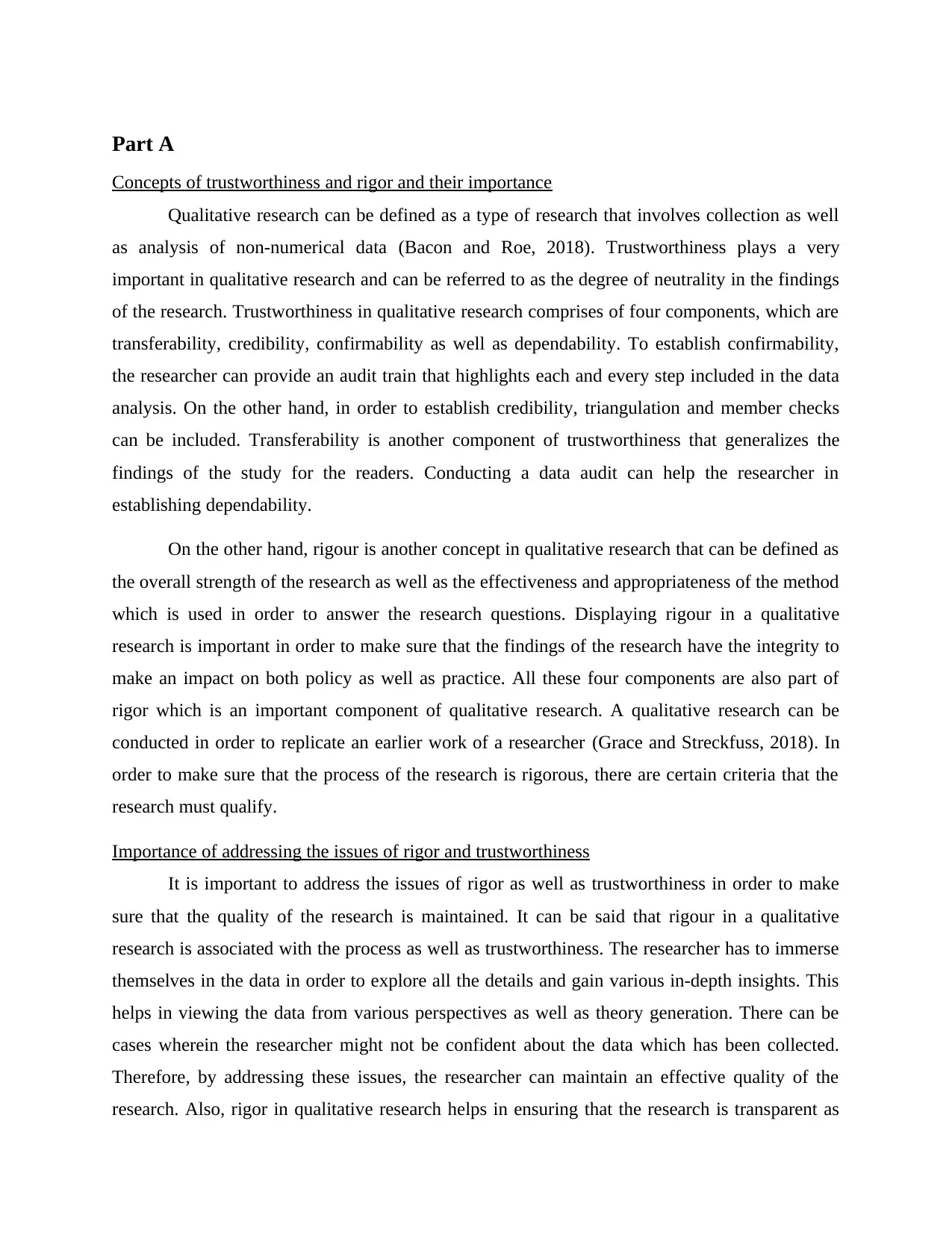
Part A
Concepts of trustworthiness and rigor and their importance
Qualitative research can be defined as a type of research that involves collection as well
as analysis of non-numerical data (Bacon and Roe, 2018). Trustworthiness plays a very
important in qualitative research and can be referred to as the degree of neutrality in the findings
of the research. Trustworthiness in qualitative research comprises of four components, which are
transferability, credibility, confirmability as well as dependability. To establish confirmability,
the researcher can provide an audit train that highlights each and every step included in the data
analysis. On the other hand, in order to establish credibility, triangulation and member checks
can be included. Transferability is another component of trustworthiness that generalizes the
findings of the study for the readers. Conducting a data audit can help the researcher in
establishing dependability.
On the other hand, rigour is another concept in qualitative research that can be defined as
the overall strength of the research as well as the effectiveness and appropriateness of the method
which is used in order to answer the research questions. Displaying rigour in a qualitative
research is important in order to make sure that the findings of the research have the integrity to
make an impact on both policy as well as practice. All these four components are also part of
rigor which is an important component of qualitative research. A qualitative research can be
conducted in order to replicate an earlier work of a researcher (Grace and Streckfuss, 2018). In
order to make sure that the process of the research is rigorous, there are certain criteria that the
research must qualify.
Importance of addressing the issues of rigor and trustworthiness
It is important to address the issues of rigor as well as trustworthiness in order to make
sure that the quality of the research is maintained. It can be said that rigour in a qualitative
research is associated with the process as well as trustworthiness. The researcher has to immerse
themselves in the data in order to explore all the details and gain various in-depth insights. This
helps in viewing the data from various perspectives as well as theory generation. There can be
cases wherein the researcher might not be confident about the data which has been collected.
Therefore, by addressing these issues, the researcher can maintain an effective quality of the
research. Also, rigor in qualitative research helps in ensuring that the research is transparent as
Concepts of trustworthiness and rigor and their importance
Qualitative research can be defined as a type of research that involves collection as well
as analysis of non-numerical data (Bacon and Roe, 2018). Trustworthiness plays a very
important in qualitative research and can be referred to as the degree of neutrality in the findings
of the research. Trustworthiness in qualitative research comprises of four components, which are
transferability, credibility, confirmability as well as dependability. To establish confirmability,
the researcher can provide an audit train that highlights each and every step included in the data
analysis. On the other hand, in order to establish credibility, triangulation and member checks
can be included. Transferability is another component of trustworthiness that generalizes the
findings of the study for the readers. Conducting a data audit can help the researcher in
establishing dependability.
On the other hand, rigour is another concept in qualitative research that can be defined as
the overall strength of the research as well as the effectiveness and appropriateness of the method
which is used in order to answer the research questions. Displaying rigour in a qualitative
research is important in order to make sure that the findings of the research have the integrity to
make an impact on both policy as well as practice. All these four components are also part of
rigor which is an important component of qualitative research. A qualitative research can be
conducted in order to replicate an earlier work of a researcher (Grace and Streckfuss, 2018). In
order to make sure that the process of the research is rigorous, there are certain criteria that the
research must qualify.
Importance of addressing the issues of rigor and trustworthiness
It is important to address the issues of rigor as well as trustworthiness in order to make
sure that the quality of the research is maintained. It can be said that rigour in a qualitative
research is associated with the process as well as trustworthiness. The researcher has to immerse
themselves in the data in order to explore all the details and gain various in-depth insights. This
helps in viewing the data from various perspectives as well as theory generation. There can be
cases wherein the researcher might not be confident about the data which has been collected.
Therefore, by addressing these issues, the researcher can maintain an effective quality of the
research. Also, rigor in qualitative research helps in ensuring that the research is transparent as
⊘ This is a preview!⊘
Do you want full access?
Subscribe today to unlock all pages.

Trusted by 1+ million students worldwide
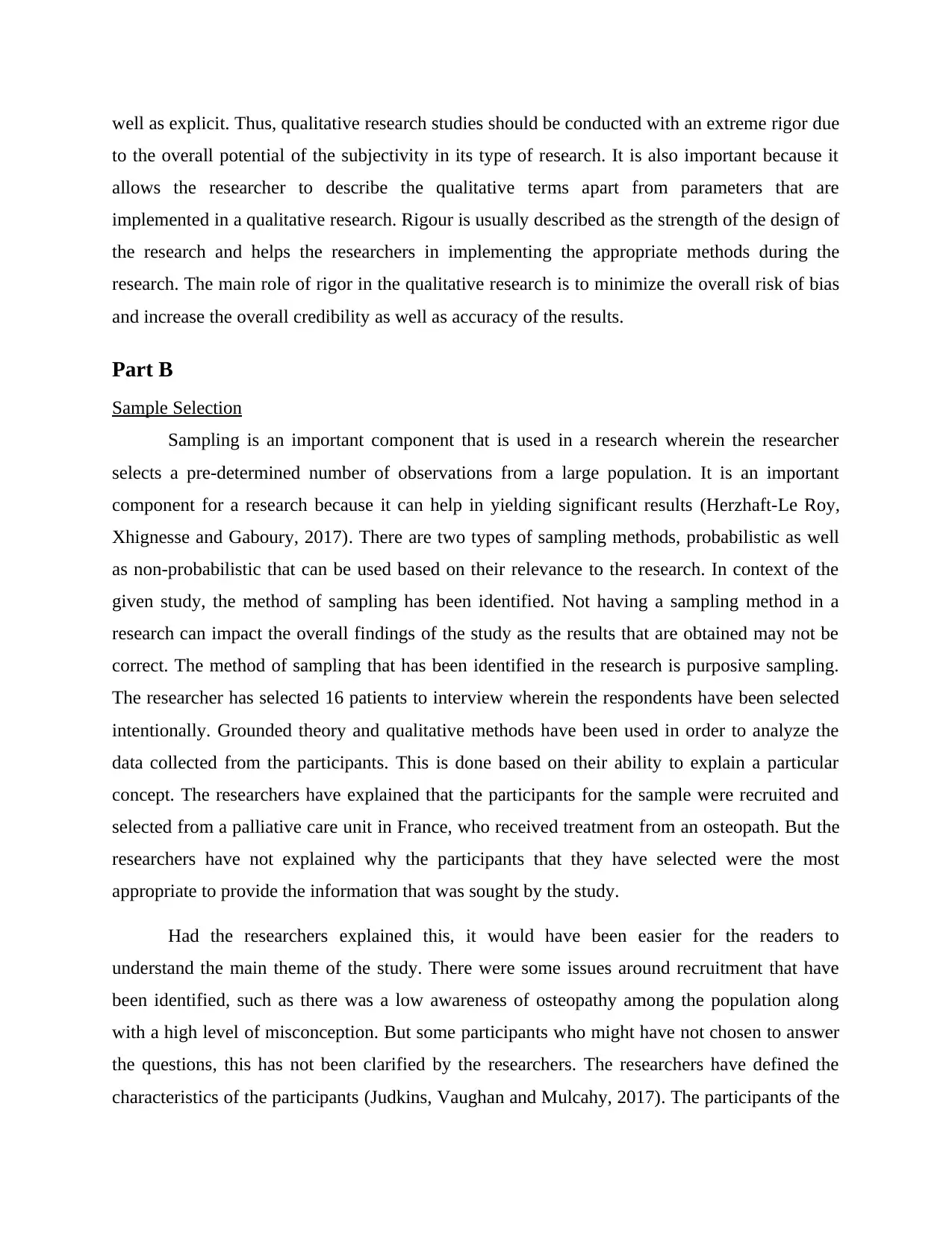
well as explicit. Thus, qualitative research studies should be conducted with an extreme rigor due
to the overall potential of the subjectivity in its type of research. It is also important because it
allows the researcher to describe the qualitative terms apart from parameters that are
implemented in a qualitative research. Rigour is usually described as the strength of the design of
the research and helps the researchers in implementing the appropriate methods during the
research. The main role of rigor in the qualitative research is to minimize the overall risk of bias
and increase the overall credibility as well as accuracy of the results.
Part B
Sample Selection
Sampling is an important component that is used in a research wherein the researcher
selects a pre-determined number of observations from a large population. It is an important
component for a research because it can help in yielding significant results (Herzhaft-Le Roy,
Xhignesse and Gaboury, 2017). There are two types of sampling methods, probabilistic as well
as non-probabilistic that can be used based on their relevance to the research. In context of the
given study, the method of sampling has been identified. Not having a sampling method in a
research can impact the overall findings of the study as the results that are obtained may not be
correct. The method of sampling that has been identified in the research is purposive sampling.
The researcher has selected 16 patients to interview wherein the respondents have been selected
intentionally. Grounded theory and qualitative methods have been used in order to analyze the
data collected from the participants. This is done based on their ability to explain a particular
concept. The researchers have explained that the participants for the sample were recruited and
selected from a palliative care unit in France, who received treatment from an osteopath. But the
researchers have not explained why the participants that they have selected were the most
appropriate to provide the information that was sought by the study.
Had the researchers explained this, it would have been easier for the readers to
understand the main theme of the study. There were some issues around recruitment that have
been identified, such as there was a low awareness of osteopathy among the population along
with a high level of misconception. But some participants who might have not chosen to answer
the questions, this has not been clarified by the researchers. The researchers have defined the
characteristics of the participants (Judkins, Vaughan and Mulcahy, 2017). The participants of the
to the overall potential of the subjectivity in its type of research. It is also important because it
allows the researcher to describe the qualitative terms apart from parameters that are
implemented in a qualitative research. Rigour is usually described as the strength of the design of
the research and helps the researchers in implementing the appropriate methods during the
research. The main role of rigor in the qualitative research is to minimize the overall risk of bias
and increase the overall credibility as well as accuracy of the results.
Part B
Sample Selection
Sampling is an important component that is used in a research wherein the researcher
selects a pre-determined number of observations from a large population. It is an important
component for a research because it can help in yielding significant results (Herzhaft-Le Roy,
Xhignesse and Gaboury, 2017). There are two types of sampling methods, probabilistic as well
as non-probabilistic that can be used based on their relevance to the research. In context of the
given study, the method of sampling has been identified. Not having a sampling method in a
research can impact the overall findings of the study as the results that are obtained may not be
correct. The method of sampling that has been identified in the research is purposive sampling.
The researcher has selected 16 patients to interview wherein the respondents have been selected
intentionally. Grounded theory and qualitative methods have been used in order to analyze the
data collected from the participants. This is done based on their ability to explain a particular
concept. The researchers have explained that the participants for the sample were recruited and
selected from a palliative care unit in France, who received treatment from an osteopath. But the
researchers have not explained why the participants that they have selected were the most
appropriate to provide the information that was sought by the study.
Had the researchers explained this, it would have been easier for the readers to
understand the main theme of the study. There were some issues around recruitment that have
been identified, such as there was a low awareness of osteopathy among the population along
with a high level of misconception. But some participants who might have not chosen to answer
the questions, this has not been clarified by the researchers. The researchers have defined the
characteristics of the participants (Judkins, Vaughan and Mulcahy, 2017). The participants of the
Paraphrase This Document
Need a fresh take? Get an instant paraphrase of this document with our AI Paraphraser
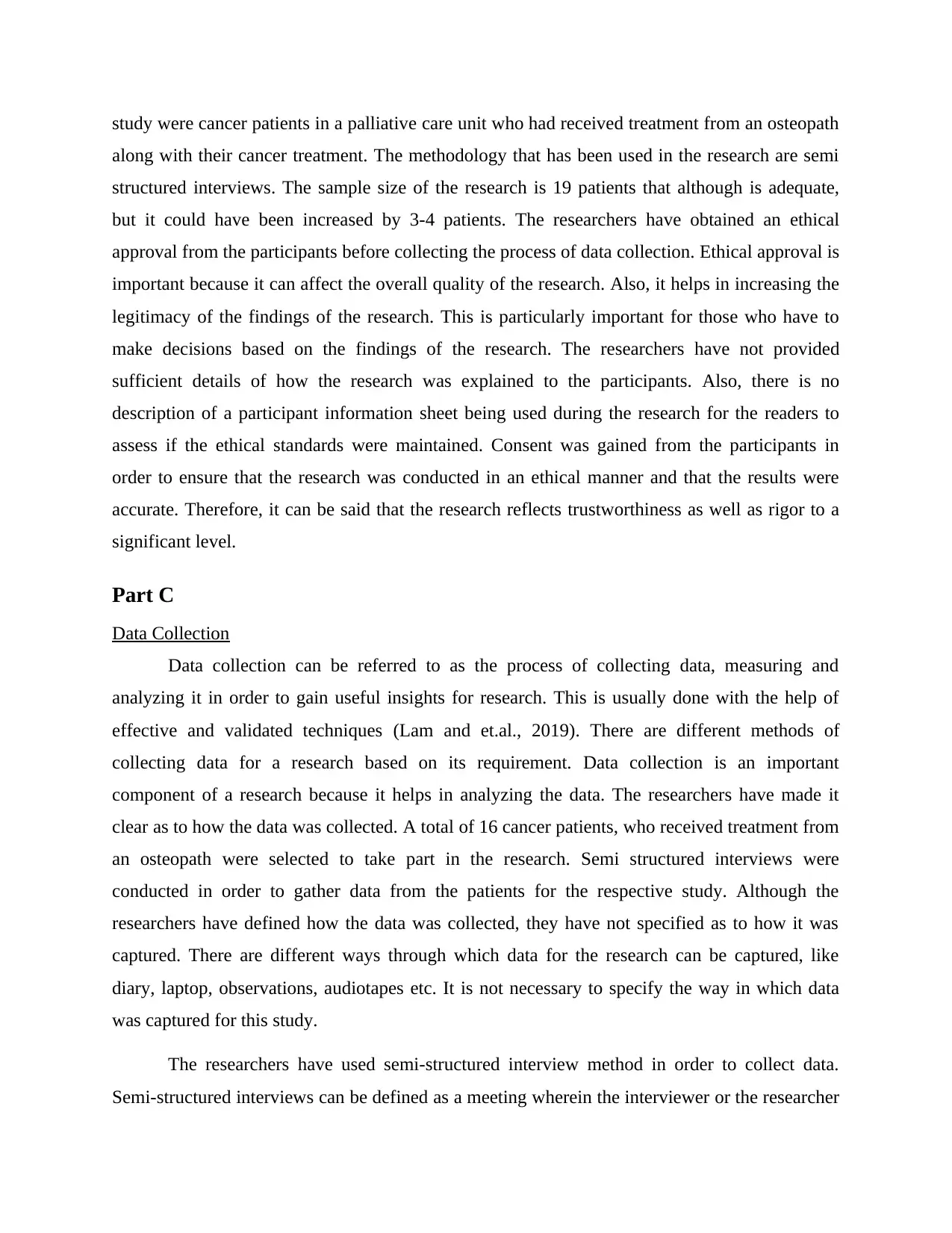
study were cancer patients in a palliative care unit who had received treatment from an osteopath
along with their cancer treatment. The methodology that has been used in the research are semi
structured interviews. The sample size of the research is 19 patients that although is adequate,
but it could have been increased by 3-4 patients. The researchers have obtained an ethical
approval from the participants before collecting the process of data collection. Ethical approval is
important because it can affect the overall quality of the research. Also, it helps in increasing the
legitimacy of the findings of the research. This is particularly important for those who have to
make decisions based on the findings of the research. The researchers have not provided
sufficient details of how the research was explained to the participants. Also, there is no
description of a participant information sheet being used during the research for the readers to
assess if the ethical standards were maintained. Consent was gained from the participants in
order to ensure that the research was conducted in an ethical manner and that the results were
accurate. Therefore, it can be said that the research reflects trustworthiness as well as rigor to a
significant level.
Part C
Data Collection
Data collection can be referred to as the process of collecting data, measuring and
analyzing it in order to gain useful insights for research. This is usually done with the help of
effective and validated techniques (Lam and et.al., 2019). There are different methods of
collecting data for a research based on its requirement. Data collection is an important
component of a research because it helps in analyzing the data. The researchers have made it
clear as to how the data was collected. A total of 16 cancer patients, who received treatment from
an osteopath were selected to take part in the research. Semi structured interviews were
conducted in order to gather data from the patients for the respective study. Although the
researchers have defined how the data was collected, they have not specified as to how it was
captured. There are different ways through which data for the research can be captured, like
diary, laptop, observations, audiotapes etc. It is not necessary to specify the way in which data
was captured for this study.
The researchers have used semi-structured interview method in order to collect data.
Semi-structured interviews can be defined as a meeting wherein the interviewer or the researcher
along with their cancer treatment. The methodology that has been used in the research are semi
structured interviews. The sample size of the research is 19 patients that although is adequate,
but it could have been increased by 3-4 patients. The researchers have obtained an ethical
approval from the participants before collecting the process of data collection. Ethical approval is
important because it can affect the overall quality of the research. Also, it helps in increasing the
legitimacy of the findings of the research. This is particularly important for those who have to
make decisions based on the findings of the research. The researchers have not provided
sufficient details of how the research was explained to the participants. Also, there is no
description of a participant information sheet being used during the research for the readers to
assess if the ethical standards were maintained. Consent was gained from the participants in
order to ensure that the research was conducted in an ethical manner and that the results were
accurate. Therefore, it can be said that the research reflects trustworthiness as well as rigor to a
significant level.
Part C
Data Collection
Data collection can be referred to as the process of collecting data, measuring and
analyzing it in order to gain useful insights for research. This is usually done with the help of
effective and validated techniques (Lam and et.al., 2019). There are different methods of
collecting data for a research based on its requirement. Data collection is an important
component of a research because it helps in analyzing the data. The researchers have made it
clear as to how the data was collected. A total of 16 cancer patients, who received treatment from
an osteopath were selected to take part in the research. Semi structured interviews were
conducted in order to gather data from the patients for the respective study. Although the
researchers have defined how the data was collected, they have not specified as to how it was
captured. There are different ways through which data for the research can be captured, like
diary, laptop, observations, audiotapes etc. It is not necessary to specify the way in which data
was captured for this study.
The researchers have used semi-structured interview method in order to collect data.
Semi-structured interviews can be defined as a meeting wherein the interviewer or the researcher
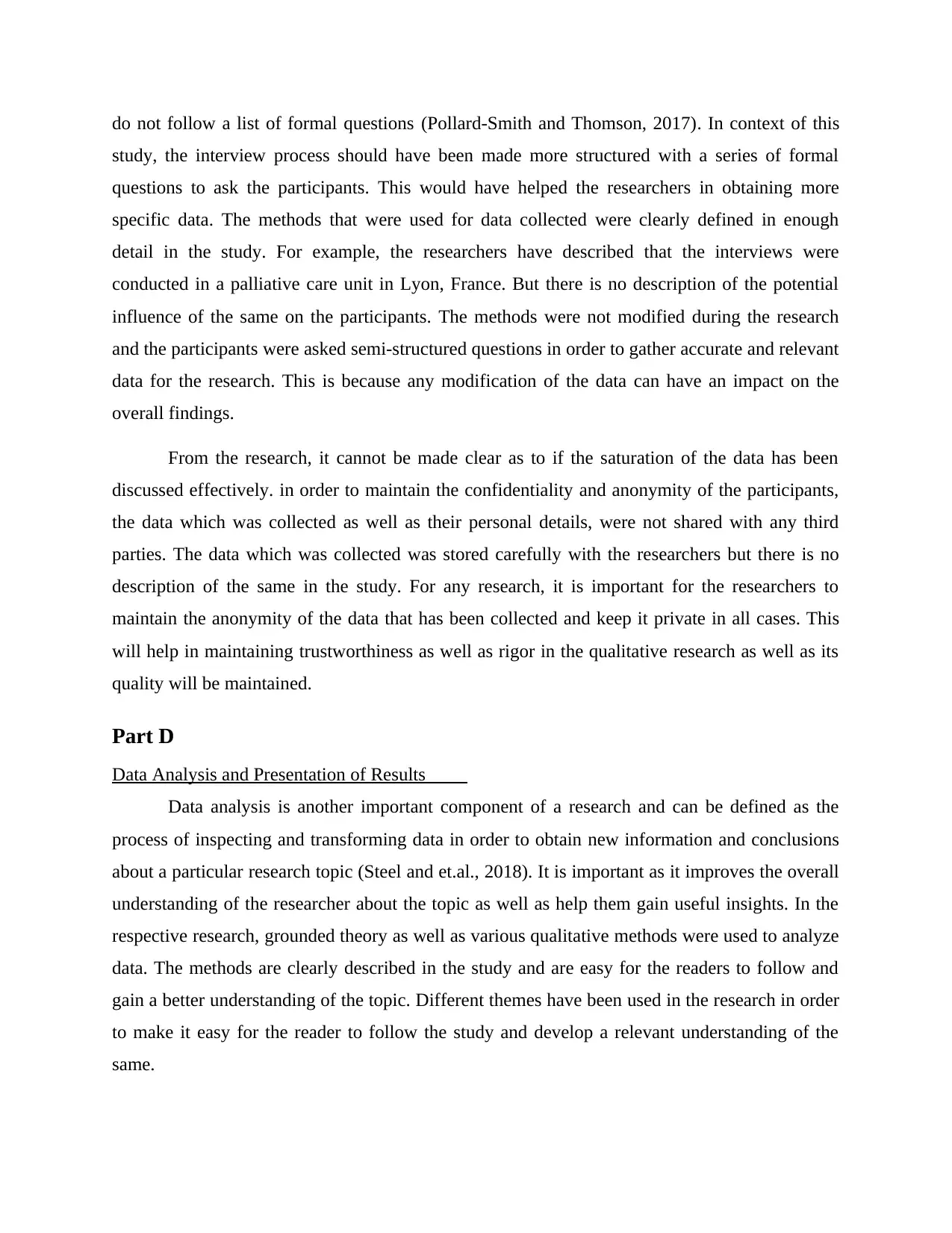
do not follow a list of formal questions (Pollard-Smith and Thomson, 2017). In context of this
study, the interview process should have been made more structured with a series of formal
questions to ask the participants. This would have helped the researchers in obtaining more
specific data. The methods that were used for data collected were clearly defined in enough
detail in the study. For example, the researchers have described that the interviews were
conducted in a palliative care unit in Lyon, France. But there is no description of the potential
influence of the same on the participants. The methods were not modified during the research
and the participants were asked semi-structured questions in order to gather accurate and relevant
data for the research. This is because any modification of the data can have an impact on the
overall findings.
From the research, it cannot be made clear as to if the saturation of the data has been
discussed effectively. in order to maintain the confidentiality and anonymity of the participants,
the data which was collected as well as their personal details, were not shared with any third
parties. The data which was collected was stored carefully with the researchers but there is no
description of the same in the study. For any research, it is important for the researchers to
maintain the anonymity of the data that has been collected and keep it private in all cases. This
will help in maintaining trustworthiness as well as rigor in the qualitative research as well as its
quality will be maintained.
Part D
Data Analysis and Presentation of Results
Data analysis is another important component of a research and can be defined as the
process of inspecting and transforming data in order to obtain new information and conclusions
about a particular research topic (Steel and et.al., 2018). It is important as it improves the overall
understanding of the researcher about the topic as well as help them gain useful insights. In the
respective research, grounded theory as well as various qualitative methods were used to analyze
data. The methods are clearly described in the study and are easy for the readers to follow and
gain a better understanding of the topic. Different themes have been used in the research in order
to make it easy for the reader to follow the study and develop a relevant understanding of the
same.
study, the interview process should have been made more structured with a series of formal
questions to ask the participants. This would have helped the researchers in obtaining more
specific data. The methods that were used for data collected were clearly defined in enough
detail in the study. For example, the researchers have described that the interviews were
conducted in a palliative care unit in Lyon, France. But there is no description of the potential
influence of the same on the participants. The methods were not modified during the research
and the participants were asked semi-structured questions in order to gather accurate and relevant
data for the research. This is because any modification of the data can have an impact on the
overall findings.
From the research, it cannot be made clear as to if the saturation of the data has been
discussed effectively. in order to maintain the confidentiality and anonymity of the participants,
the data which was collected as well as their personal details, were not shared with any third
parties. The data which was collected was stored carefully with the researchers but there is no
description of the same in the study. For any research, it is important for the researchers to
maintain the anonymity of the data that has been collected and keep it private in all cases. This
will help in maintaining trustworthiness as well as rigor in the qualitative research as well as its
quality will be maintained.
Part D
Data Analysis and Presentation of Results
Data analysis is another important component of a research and can be defined as the
process of inspecting and transforming data in order to obtain new information and conclusions
about a particular research topic (Steel and et.al., 2018). It is important as it improves the overall
understanding of the researcher about the topic as well as help them gain useful insights. In the
respective research, grounded theory as well as various qualitative methods were used to analyze
data. The methods are clearly described in the study and are easy for the readers to follow and
gain a better understanding of the topic. Different themes have been used in the research in order
to make it easy for the reader to follow the study and develop a relevant understanding of the
same.
⊘ This is a preview!⊘
Do you want full access?
Subscribe today to unlock all pages.

Trusted by 1+ million students worldwide
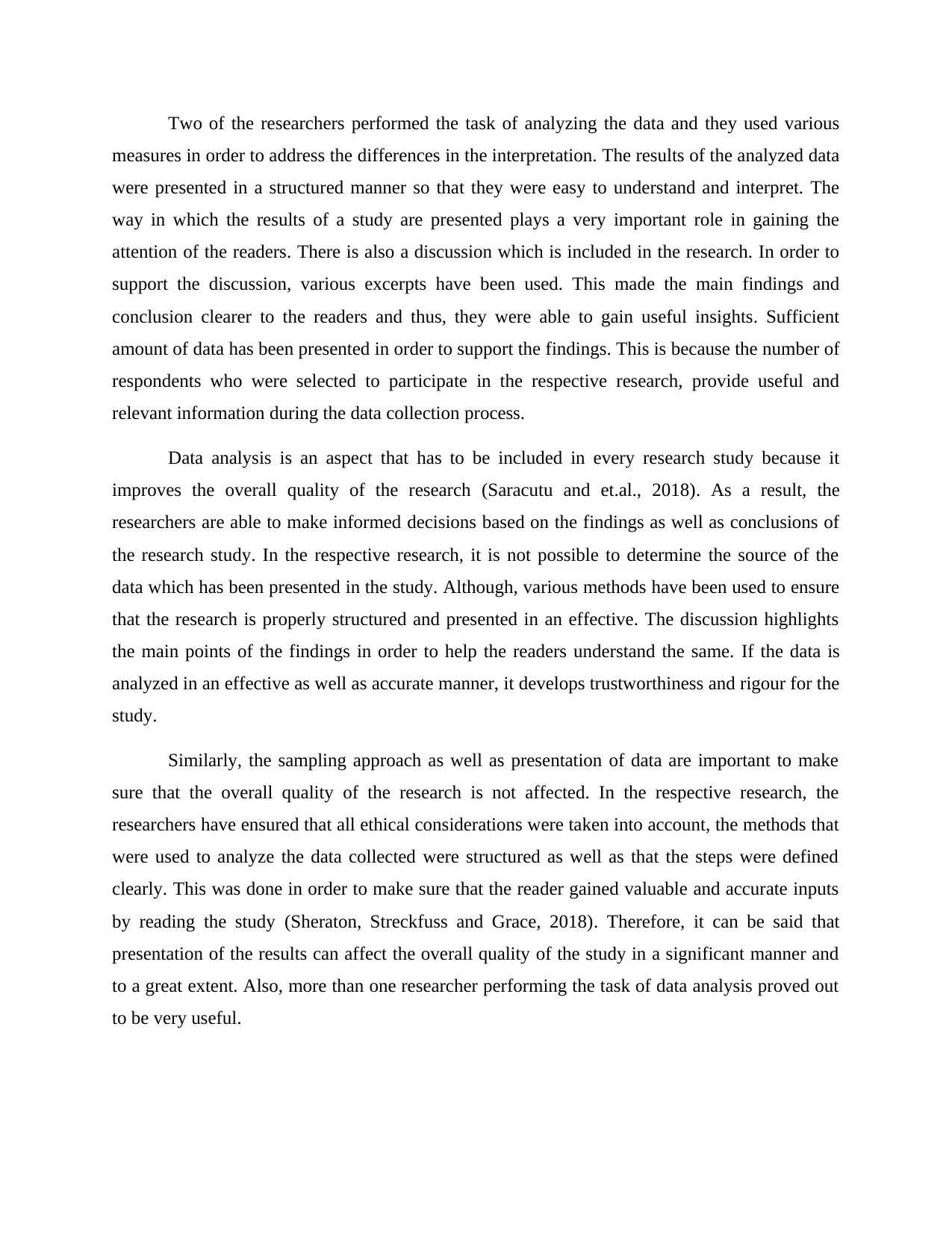
Two of the researchers performed the task of analyzing the data and they used various
measures in order to address the differences in the interpretation. The results of the analyzed data
were presented in a structured manner so that they were easy to understand and interpret. The
way in which the results of a study are presented plays a very important role in gaining the
attention of the readers. There is also a discussion which is included in the research. In order to
support the discussion, various excerpts have been used. This made the main findings and
conclusion clearer to the readers and thus, they were able to gain useful insights. Sufficient
amount of data has been presented in order to support the findings. This is because the number of
respondents who were selected to participate in the respective research, provide useful and
relevant information during the data collection process.
Data analysis is an aspect that has to be included in every research study because it
improves the overall quality of the research (Saracutu and et.al., 2018). As a result, the
researchers are able to make informed decisions based on the findings as well as conclusions of
the research study. In the respective research, it is not possible to determine the source of the
data which has been presented in the study. Although, various methods have been used to ensure
that the research is properly structured and presented in an effective. The discussion highlights
the main points of the findings in order to help the readers understand the same. If the data is
analyzed in an effective as well as accurate manner, it develops trustworthiness and rigour for the
study.
Similarly, the sampling approach as well as presentation of data are important to make
sure that the overall quality of the research is not affected. In the respective research, the
researchers have ensured that all ethical considerations were taken into account, the methods that
were used to analyze the data collected were structured as well as that the steps were defined
clearly. This was done in order to make sure that the reader gained valuable and accurate inputs
by reading the study (Sheraton, Streckfuss and Grace, 2018). Therefore, it can be said that
presentation of the results can affect the overall quality of the study in a significant manner and
to a great extent. Also, more than one researcher performing the task of data analysis proved out
to be very useful.
measures in order to address the differences in the interpretation. The results of the analyzed data
were presented in a structured manner so that they were easy to understand and interpret. The
way in which the results of a study are presented plays a very important role in gaining the
attention of the readers. There is also a discussion which is included in the research. In order to
support the discussion, various excerpts have been used. This made the main findings and
conclusion clearer to the readers and thus, they were able to gain useful insights. Sufficient
amount of data has been presented in order to support the findings. This is because the number of
respondents who were selected to participate in the respective research, provide useful and
relevant information during the data collection process.
Data analysis is an aspect that has to be included in every research study because it
improves the overall quality of the research (Saracutu and et.al., 2018). As a result, the
researchers are able to make informed decisions based on the findings as well as conclusions of
the research study. In the respective research, it is not possible to determine the source of the
data which has been presented in the study. Although, various methods have been used to ensure
that the research is properly structured and presented in an effective. The discussion highlights
the main points of the findings in order to help the readers understand the same. If the data is
analyzed in an effective as well as accurate manner, it develops trustworthiness and rigour for the
study.
Similarly, the sampling approach as well as presentation of data are important to make
sure that the overall quality of the research is not affected. In the respective research, the
researchers have ensured that all ethical considerations were taken into account, the methods that
were used to analyze the data collected were structured as well as that the steps were defined
clearly. This was done in order to make sure that the reader gained valuable and accurate inputs
by reading the study (Sheraton, Streckfuss and Grace, 2018). Therefore, it can be said that
presentation of the results can affect the overall quality of the study in a significant manner and
to a great extent. Also, more than one researcher performing the task of data analysis proved out
to be very useful.
Paraphrase This Document
Need a fresh take? Get an instant paraphrase of this document with our AI Paraphraser
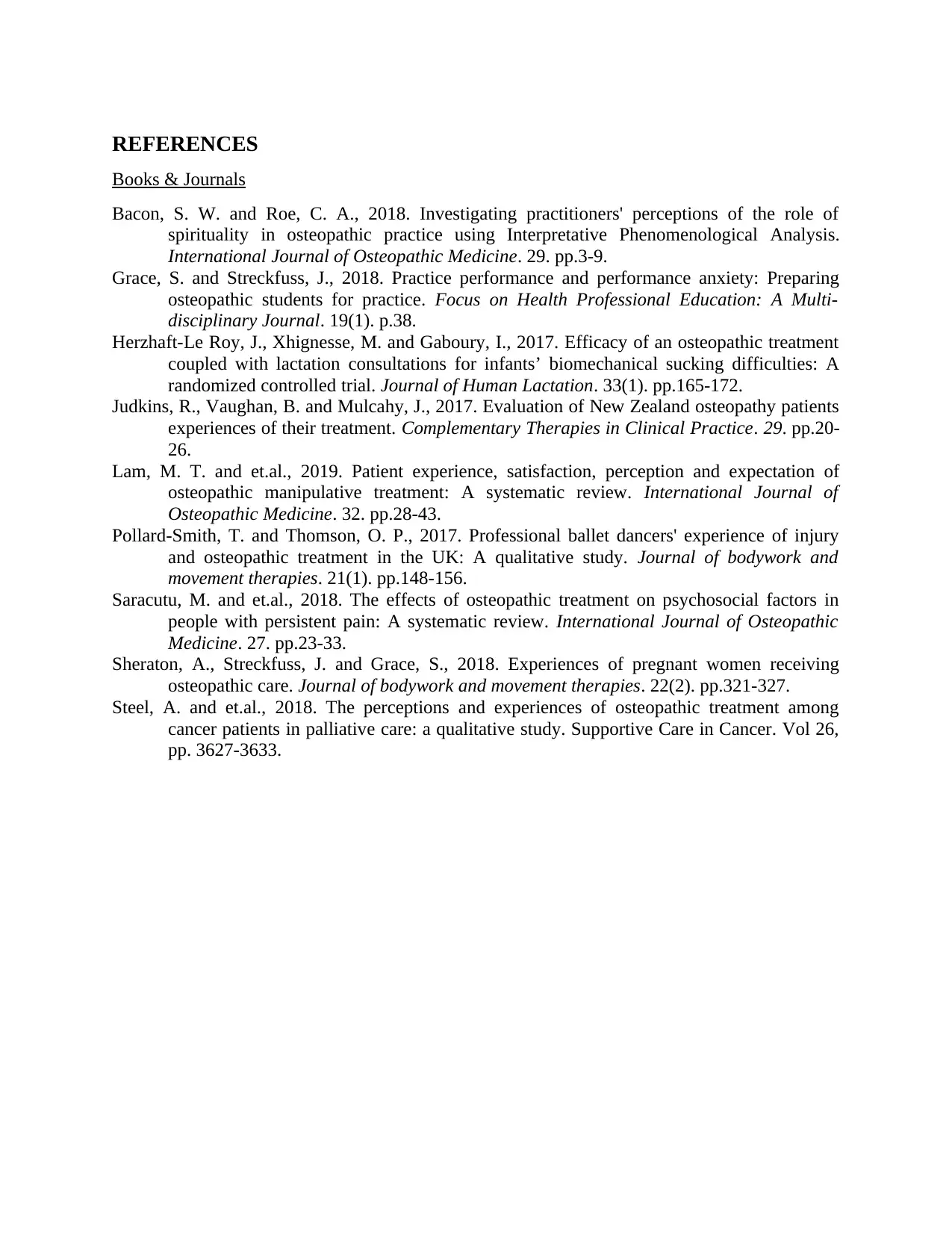
REFERENCES
Books & Journals
Bacon, S. W. and Roe, C. A., 2018. Investigating practitioners' perceptions of the role of
spirituality in osteopathic practice using Interpretative Phenomenological Analysis.
International Journal of Osteopathic Medicine. 29. pp.3-9.
Grace, S. and Streckfuss, J., 2018. Practice performance and performance anxiety: Preparing
osteopathic students for practice. Focus on Health Professional Education: A Multi-
disciplinary Journal. 19(1). p.38.
Herzhaft-Le Roy, J., Xhignesse, M. and Gaboury, I., 2017. Efficacy of an osteopathic treatment
coupled with lactation consultations for infants’ biomechanical sucking difficulties: A
randomized controlled trial. Journal of Human Lactation. 33(1). pp.165-172.
Judkins, R., Vaughan, B. and Mulcahy, J., 2017. Evaluation of New Zealand osteopathy patients
experiences of their treatment. Complementary Therapies in Clinical Practice. 29. pp.20-
26.
Lam, M. T. and et.al., 2019. Patient experience, satisfaction, perception and expectation of
osteopathic manipulative treatment: A systematic review. International Journal of
Osteopathic Medicine. 32. pp.28-43.
Pollard-Smith, T. and Thomson, O. P., 2017. Professional ballet dancers' experience of injury
and osteopathic treatment in the UK: A qualitative study. Journal of bodywork and
movement therapies. 21(1). pp.148-156.
Saracutu, M. and et.al., 2018. The effects of osteopathic treatment on psychosocial factors in
people with persistent pain: A systematic review. International Journal of Osteopathic
Medicine. 27. pp.23-33.
Sheraton, A., Streckfuss, J. and Grace, S., 2018. Experiences of pregnant women receiving
osteopathic care. Journal of bodywork and movement therapies. 22(2). pp.321-327.
Steel, A. and et.al., 2018. The perceptions and experiences of osteopathic treatment among
cancer patients in palliative care: a qualitative study. Supportive Care in Cancer. Vol 26,
pp. 3627-3633.
Books & Journals
Bacon, S. W. and Roe, C. A., 2018. Investigating practitioners' perceptions of the role of
spirituality in osteopathic practice using Interpretative Phenomenological Analysis.
International Journal of Osteopathic Medicine. 29. pp.3-9.
Grace, S. and Streckfuss, J., 2018. Practice performance and performance anxiety: Preparing
osteopathic students for practice. Focus on Health Professional Education: A Multi-
disciplinary Journal. 19(1). p.38.
Herzhaft-Le Roy, J., Xhignesse, M. and Gaboury, I., 2017. Efficacy of an osteopathic treatment
coupled with lactation consultations for infants’ biomechanical sucking difficulties: A
randomized controlled trial. Journal of Human Lactation. 33(1). pp.165-172.
Judkins, R., Vaughan, B. and Mulcahy, J., 2017. Evaluation of New Zealand osteopathy patients
experiences of their treatment. Complementary Therapies in Clinical Practice. 29. pp.20-
26.
Lam, M. T. and et.al., 2019. Patient experience, satisfaction, perception and expectation of
osteopathic manipulative treatment: A systematic review. International Journal of
Osteopathic Medicine. 32. pp.28-43.
Pollard-Smith, T. and Thomson, O. P., 2017. Professional ballet dancers' experience of injury
and osteopathic treatment in the UK: A qualitative study. Journal of bodywork and
movement therapies. 21(1). pp.148-156.
Saracutu, M. and et.al., 2018. The effects of osteopathic treatment on psychosocial factors in
people with persistent pain: A systematic review. International Journal of Osteopathic
Medicine. 27. pp.23-33.
Sheraton, A., Streckfuss, J. and Grace, S., 2018. Experiences of pregnant women receiving
osteopathic care. Journal of bodywork and movement therapies. 22(2). pp.321-327.
Steel, A. and et.al., 2018. The perceptions and experiences of osteopathic treatment among
cancer patients in palliative care: a qualitative study. Supportive Care in Cancer. Vol 26,
pp. 3627-3633.
1 out of 8
Related Documents
Your All-in-One AI-Powered Toolkit for Academic Success.
+13062052269
info@desklib.com
Available 24*7 on WhatsApp / Email
![[object Object]](/_next/static/media/star-bottom.7253800d.svg)
Unlock your academic potential
Copyright © 2020–2025 A2Z Services. All Rights Reserved. Developed and managed by ZUCOL.





